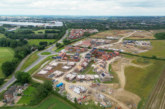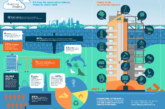
A research report released by Southern Construction Framework (SCF) reveals an encouraging 6% tender workload increase across the industry during Q2 (April to June), 11% higher when compared to this same time last year.
However, with just an average 1% increase in workforce during the same period, many projects could stall with a lack of staff resource.
SCF is a leading construction procurement framework delivered by the public sector for the public sector in the South of England.
The quarterly benchmarking survey gives insight into the supply chain from suppliers and contractors and supports contractor decision making about material specification, construction methodology, offsite or automated construction techniques and project planning and programming.
With an injection of capital investment over the past 24 months by Central Government with funding streams including Levelling Up, Building Safety, the School Rebuilding Programme and Salix Decarbonisation, tender workload has been strong with 11% across all trades. Concrete frames have seen the highest increase (17%) followed by dry lining (11%) and Brickwork and M&E at 6%.
But this quarter’s report reveals a minimal increase in employment throughout Q2, with an average 1% increase in the number of employees across all trades. The dry lining, windows and M&E trades saw a slightly higher increase at 3%, 2% and 2% respectively.
Forecasts for the next quarter are even more concerning with the number of Steelwork employees anticipated to decrease by 1% over the next 12 months, and no change anticipated for tower crane, carpentry and joinery and groundworks.
The report forecasts a more modest 3% increase in tender workload for the next quarter, suggesting a slowing of pipeline as the potential for a recession emerges and the supply chain lacks confidence to recruit.
Kingsley Clarke, SCF Operations Lead for the South West, said: “Following the pandemic, many workers have chosen early retirement. This has exaggerated the skills shortage, which was already vulnerable to an ageing workforce. The CITB estimates that for us to deliver the pipeline in place for 2025, we will need an additional 40,000 workers per year.
“Many contractors warn that with an increase in the length of preconstruction programmes, many project teams will try to streamline construction with an increased workforce on site, but that is going to be challenging with the current labour shortage.”
Building Costs
Compounding the staff resource shortage, the report reveals yet another increase in building costs, 11% over Q2 alone, which is 22% higher than this same time last year. Steelwork costs have gone up by a staggering 25% in the last quarter alone, with dry lining up 17%, curtain walling up by 13% and windows at a 11% increase.
Trades’ supply chain are forecasting little change in the next 12 months with an average increase in building cost of 10% across all trades predicted.
SCF Main Contractors caution that the commodity price of crude oil and natural gas is now 86.96% and 199.49% greater than this same time last year. China has also now adopted a Zero Covid Strategy, which has resulted in manufacturing and logistical lockdowns that has rippled across global supply chains.
Adam Sanford, SCF Operations Lead for London and the South East, added: “Contractors and the supply chain continue to experience difficulties in sourcing fixed prices from suppliers and to this end high risk pricing is frequent.
“The continued stress of high inflation has the potential to apply pressure to profit margins, particularly that of SMEs and those with premature fixed prices. This could see the supply chain adopting a guarded approach to risk, who will look to selectively target opportunities that they can comfortably deliver upon.”
Materials availability
The good news is that the research shows that trade supply chains have seen material availability increase by 1.5 weeks during Q2, which is now 2.5 weeks greater than this same time last year.
Contractors have identified the greatest quarterly increase in material availability for the M&E at +3 weeks; Concrete Frame (+2 weeks) and Windows (+2 weeks). However, electrical and engineering components have been particularly challenging to source throughout Q2.
For a copy of the report: Market Intelligence – SCF (scfconstruct.org.uk)








